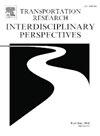综合铁路和公共汽车运输网络设计的评估:公平和效率的观点
IF 3.8
Q2 TRANSPORTATION
Transportation Research Interdisciplinary Perspectives
Pub Date : 2025-05-01
DOI:10.1016/j.trip.2025.101450
引用次数: 0
摘要
认识到公共交通在可达性、包容性和生活质量方面的重要作用,其规划必须在效率与公平的服务覆盖之间取得平衡。本研究考察了公共交通网络的设计,整合了铁路和公共汽车服务,同时纳入了公平考虑,以建立一个更有效和社会公平的系统。尽管对PuT网络设计(PTND)进行了广泛的研究,但平衡这些目标仍然是交通规划中的一个关键挑战。本文提出了一个将PTND与数据包络分析(DEA)相结合的方法框架,以设计和评估多个PTND场景。使用基于权益的视角评估这些情景:潜在需求(PD)、调整需求(AD)和运输需求(TN)。该方法确定了有效的设计,最大限度地扩大服务覆盖面和社会公平,满足不同人口的需求和需要。该方法通过波尔图大都市区(AMP)的案例研究进行了演示,为政策制定者提供了基础设施规划和决策过程中PuT公平影响的见解。开发了两个面向产出的DEA模型:一个使用服务覆盖充分性(SCA)作为产出,另一个结合SCA和基尼系数(公平性)来评估不同公平性视角对系统效率的影响。结果表明,基于AD的网络设计比PD和TN的效率得分更高,表明AD能更好地捕捉PuT需求,支持公平的服务分配。研究结果强调,需要将人口公平观点与多式联运结合起来,以创建更平衡、更高效的公共交通系统,确保该地区不同人口公平获得交通工具。本文章由计算机程序翻译,如有差异,请以英文原文为准。
Assessment of integrated rail and bus transport network design: Equity and efficiency perspectives
Recognizing the vital role of public transport (PuT) in accessibility, inclusivity, and quality of life, its planning must balance efficiency with equitable service coverage. This study examines PuT network design, integrating rail and bus services while incorporating equity considerations for a more efficient and socially equitable system. Despite extensive research on PuT network design (PTND), balancing these objectives remains a key challenge in transit planning. This paper presents a methodological framework that integrates PTND with Data Envelopment Analysis (DEA) to design and evaluate multiple PTND scenarios. These scenarios are assessed using equity-based perspectives: potential demand (PD), adjusted demand (AD), and transport needs (TN). The approach identifies efficient designs that maximize service coverage and social equity, addressing varying population demands and needs. The methodology is demonstrated through a case study in the metropolitan area of Porto (AMP), offering policymakers insights into PuT equity implications for the infrastructure planning and decision-making process. Two output-oriented DEA models were developed: one using service coverage adequacy (SCA) as output and another incorporating both SCA and the GINI coefficient (equity) to assess the impact of different equity perspectives on system efficiency. Results indicate that network designs based on AD performed better with higher efficiency scores than PD and TN, suggesting that AD better captures PuT demand needs and supports equitable service distribution. The findings emphasize the need to integrate population equity perspectives and multimodal transport to create more balanced and efficient PuT systems, ensuring fair access to mobility for diverse populations in the region.
求助全文
通过发布文献求助,成功后即可免费获取论文全文。
去求助
来源期刊

Transportation Research Interdisciplinary Perspectives
Engineering-Automotive Engineering
CiteScore
12.90
自引率
0.00%
发文量
185
审稿时长
22 weeks
 求助内容:
求助内容: 应助结果提醒方式:
应助结果提醒方式:


